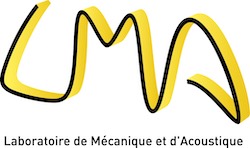Encadrement
- Directeurs : Bruno Lombard et Guillaume Chiavassa (M2P2)
- Organisme rémunérant : Allocation de recherche MESR
Jury
- Guillaume CHIAVASSA, Maître de Conférences, ECM, Co-directeur de thèse
- Thierry GOUDON, Directeur de Recherche INRIA, COFFEE, Rapporteur
- Boris GRALAK, Chargé de Recherche CNRS, Institut Fresnel, Examinateur
- Bruno LOMBARD, Chargé de Recherche CNRS, LMA, Directeur de thèse
- Jean-François MERCIER, Chargé de Recherche CNRS, ENSTA, Examinateur
- Andrew NORRIS, Distinguished Professor, Rutgers University, USA, Rapporteur
- Vincent PAGNEUX, Directeur de Recherche CNRS, LAUM, Examinateur
- Pierre SUQUET, Directeur de Recherche CNRS, LMA, Examinateur
Résumé
A time-domain numerical modeling of Biot poroelastic waves is proposed.
The viscous dissipation occurring in the pores is described using the dynamic permeability model developed by Johnson-Koplik-Dashen (JKD). Some of the coefficients in the Biot-JKD model are proportional to the square root of the frequency : in the time-domain, these coefficients introduce shifted fractional derivatives of order 1/2, involving a convolution product. Based on a diffusive representation, the convolution kernel is replaced by a finite number of memory variables that satisfy local-in-time ordinary differential equations, resulting in the Biot-DA (diffusive approximation) model. The properties of both the Biot-JKD model and the Biot-DA model are analyzed : hyperbolicity, decrease of energy, dispersion. To determine the coefficients of the diffusive approximation, different methods of quadrature are analyzed : Gaussian quadratures, linear or nonlinear optimization procedures in the frequency range of interest. The nonlinear optimization is shown to be the better way of determination. A splitting strategy is then applied numerically : the propagative part of Biot-JKD equations is discretized using a fourth-order ADER scheme on a Cartesian grid, whereas the diffusive part is solved exactly. An immersed interface method is implemented to discretize the geometry on a Cartesian grid and also to discretize the jump conditions at interfaces.
Numerical experiments are presented, for isotropic and transversely isotropic media. Comparisons with analytical solutions show the efficiency and the accuracy of this approach. Some numerical experiments are performed to investigate wave phenomena in complex media : influence of the porosity of a cancellous bone, multiple scattering across a set of random scatterers.


